汽车发展史_(英文分析
汽车历史发展的有关介绍英语作文
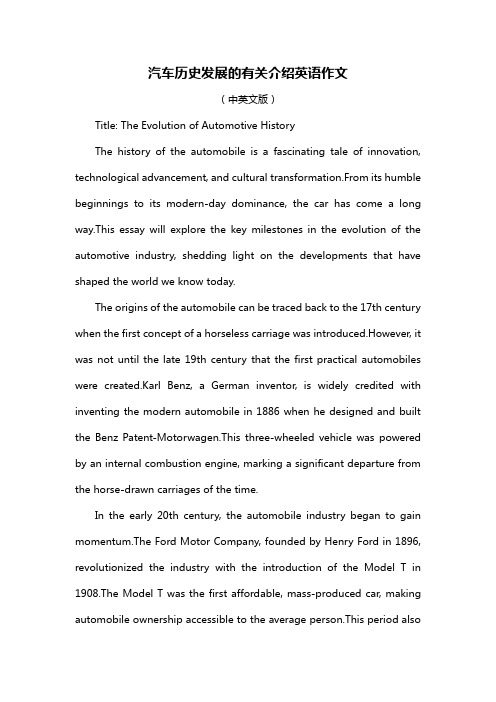
汽车历史发展的有关介绍英语作文(中英文版)Title: The Evolution of Automotive HistoryThe history of the automobile is a fascinating tale of innovation, technological advancement, and cultural transformation.From its humble beginnings to its modern-day dominance, the car has come a long way.This essay will explore the key milestones in the evolution of the automotive industry, shedding light on the developments that have shaped the world we know today.The origins of the automobile can be traced back to the 17th century when the first concept of a horseless carriage was introduced.However, it was not until the late 19th century that the first practical automobiles were created.Karl Benz, a German inventor, is widely credited with inventing the modern automobile in 1886 when he designed and built the Benz Patent-Motorwagen.This three-wheeled vehicle was powered by an internal combustion engine, marking a significant departure from the horse-drawn carriages of the time.In the early 20th century, the automobile industry began to gain momentum.The Ford Motor Company, founded by Henry Ford in 1896, revolutionized the industry with the introduction of the Model T in 1908.The Model T was the first affordable, mass-produced car, making automobile ownership accessible to the average person.This period alsosaw the rise of other major automakers, such as General Motors and Chrysler, who helped to establish the United States as the world"s leading force in automobile production.The 1950s and 1960s were a golden age for the automobile industry.The post-World War II economic boom led to a surge in automobile sales, as more and more families could afford their own cars.This era was characterized by innovation, with the development of new technologies such as automatic transmissions, power steering, and air conditioning.The "Muscle Cars" of this era, with their powerful engines and sleek designs, became a symbol of American culture and freedom.However, the 1970s brought about a period of significant change in the automotive industry.The OPEC oil embargo of 1973 led to a surge in oil prices, causing a shift in consumer preferences towards smaller, more fuel-efficient cars.This shift was further exacerbated by environmental concerns and regulations, which led to the development of the first fuel-efficient "Economy Cars."In the subsequent decades, the automobile industry continued to evolve, with the emergence of new technologies and the rise of international competition.The introduction of the hybrid vehicle in the late 20th century, led by companies like Toyota and Honda, marked a significant step towards more sustainable transportation.The 21stcentury has seen the rise of electric vehicles (EVs), led by companies like Tesla, which are poised to reshape the automotive landscape once again.In conclusion, the history of the automobile is a story of continuous innovation and adaptation.From the early horseless carriages to the modern EVs, the car has become an integral part of our daily lives.As we look to the future, it is clear that the automobile industry will continue to evolve, with new technologies and sustainable practices driving the next wave of innovation.。
车的发展历史英语作文
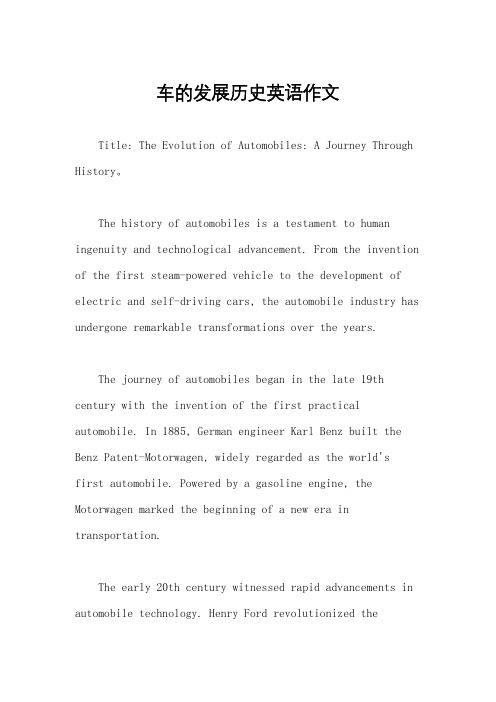
车的发展历史英语作文Title: The Evolution of Automobiles: A Journey Through History。
The history of automobiles is a testament to human ingenuity and technological advancement. From the invention of the first steam-powered vehicle to the development of electric and self-driving cars, the automobile industry has undergone remarkable transformations over the years.The journey of automobiles began in the late 19th century with the invention of the first practical automobile. In 1885, German engineer Karl Benz built the Benz Patent-Motorwagen, widely regarded as the world'sfirst automobile. Powered by a gasoline engine, the Motorwagen marked the beginning of a new era in transportation.The early 20th century witnessed rapid advancements in automobile technology. Henry Ford revolutionized theindustry with the introduction of the assembly line production system, which made cars more affordable and accessible to the masses. The Ford Model T, introduced in 1908, became one of the most iconic vehicles of the era and played a significant role in shaping modern transportation.The 1920s and 1930s saw further innovations in automobile design and engineering. Manufacturers began experimenting with new materials and technologies to improve performance, safety, and comfort. Streamlined designs and aerodynamic principles were incorporated into car designs, leading to faster and more fuel-efficient vehicles.The post-World War II period marked another significant milestone in automotive history. The economic boom of the 1950s fueled consumer demand for automobiles, leading to the mass production of cars with sleek designs and powerful engines. The rise of suburban living and the construction of interstate highways further contributed to thepopularity of automobiles as a primary mode of transportation.The latter half of the 20th century saw growingconcerns about environmental pollution and fuel consumption, prompting manufacturers to explore alternative propulsion systems. In the 1970s, the oil crisis prompted a renewed interest in fuel-efficient vehicles, leading to the development of hybrid and electric cars.The 21st century has witnessed unprecedented advancements in automotive technology. Electric vehicles (EVs) have gained popularity as concerns about climate change and air pollution have intensified. Major automakers are investing heavily in EV technology, leading to the development of long-range electric vehicles with rapid charging capabilities.Furthermore, the concept of autonomous vehicles has captured the imagination of both consumers and industry experts. Companies like Tesla, Google, and Uber are leading the race to develop self-driving cars equipped with advanced sensors and artificial intelligence algorithms. While fully autonomous vehicles are still in the testingphase, they hold the potential to revolutionize transportation by reducing accidents, traffic congestion, and carbon emissions.In conclusion, the history of automobiles is a story of innovation, perseverance, and adaptation. From humble beginnings as steam-powered contraptions to the sophisticated electric and autonomous vehicles of today, automobiles have come a long way. As we stand on the brink of a new era of transportation, it is clear that the journey of automobiles is far from over, with new technologies and breakthroughs on the horizon.。
汽车发展史英文文献

汽车发展史英文文献The Evolutionary Journey of Automobiles: From Steam-Powered to Modern Electric Vehicles.The history of the automobile is a remarkable narrative of innovation, perseverance, and engineering genius. Spanning multiple centuries, it tells a tale of continuous progress, evolution, and revolution in transportation. From the steam-powered carriages of the 18th century to the electric and autonomous vehicles of today, the automobile industry has witnessed significant milestones that have forever altered the face of transportation.The earliest precursors of the modern automobile were steam-powered carriages. These vehicles, which first appeared in the late 18th century, were bulky, slow, and often unreliable. However, they marked the beginning of a revolution in transportation, as they provided a new mode of conveyance that was not dependent on horses or other animals.In the early 19th century, several inventors and engineers began to experiment with alternative power sources for vehicles. One such individual was Nicholas-Joseph Cugnot, a French military engineer who designed and built the first self-propelled mechanical vehicle in 1769. Dubbed the "Cugnot's Fardier," this steam-powered vehicle was used by the French army to haul artillery.However, it was the German engineer Rudolf Diesel who truly revolutionized the automobile industry. In 1897, he successfully developed the first diesel engine, which operated on the principle of compression ignition. This engine was efficient, powerful, and offered a significant advantage over the gasoline engines of the time. Diesel's invention not only found widespread application in heavy-duty vehicles and locomotives but also paved the way for the development of more efficient and powerful automobiles.The turn of the 20th century marked a period of rapid innovation and growth in the automobile industry. In 1885, Karl Benz patented the first gasoline-powered automobile,the Benz Patent Motorwagen. This vehicle, which was powered by a two-stroke engine, marked the beginning of a new erain transportation. Soon after, other manufacturers began to produce their own versions of gasoline-powered cars, andthe industry began to grow rapidly.By the early 20th century, the automobile had become a popular mode of transportation for both personal and commercial use. Automobiles were now being produced inlarge numbers, and the industry was experiencing rapid growth. However, this growth was not without its challenges. The early automobiles were noisy, smelly, and emitted large amounts of exhaust fumes, which led to concerns about their impact on public health and the environment.The 1920s and 1930s saw further innovation and improvement in automobile technology. Manufacturers beganto experiment with new materials and designs, resulting in lighter, more aerodynamic vehicles. The internal combustion engine also underwent significant improvements, becoming more efficient and powerful. Additionally, the introduction of electric starters and self-starters made it easier tooperate automobiles, and the development of better roads and infrastructure further facilitated the growth of the automobile industry.The post-World War II era marked a new phase in the evolution of the automobile. With the advent of new technologies and materials, manufacturers were able to produce safer, more comfortable, and more efficient vehicles. The introduction of disc brakes, power steering, and automatic transmissions significantly improved the driving experience, while the development of high-performance materials like fiberglass and kevlar led to lighter and stronger vehicles.In recent years, the automobile industry has been transformed by the advent of electric vehicles (EVs) and autonomous driving technology. EVs, which are powered by batteries instead of fossil fuels, offer a more environmentally friendly and cost-effective mode of transportation. Autonomous driving technology, which uses sensors and algorithms to navigate and control vehicles without human intervention, has the potential torevolutionize the way we travel.The automobile industry has come a long way since its humble beginnings as steam-powered carriages. From gasoline-powered cars to electric and autonomous vehicles, the industry has continuously evolved and adapted to meet the changing needs and demands of society. As we look towards the future, it is exciting to imagine what new technologies and innovations will further transform the face of transportation.。
汽车的历史发展英语作文
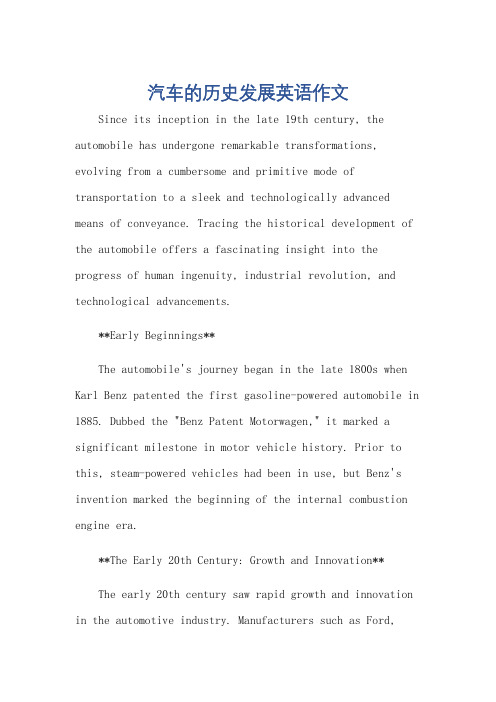
汽车的历史发展英语作文Since its inception in the late 19th century, the automobile has undergone remarkable transformations, evolving from a cumbersome and primitive mode of transportation to a sleek and technologically advanced means of conveyance. Tracing the historical development of the automobile offers a fascinating insight into the progress of human ingenuity, industrial revolution, and technological advancements.**Early Beginnings**The automobile's journey began in the late 1800s when Karl Benz patented the first gasoline-powered automobile in 1885. Dubbed the "Benz Patent Motorwagen," it marked a significant milestone in motor vehicle history. Prior to this, steam-powered vehicles had been in use, but Benz's invention marked the beginning of the internal combustion engine era.**The Early 20th Century: Growth and Innovation**The early 20th century saw rapid growth and innovation in the automotive industry. Manufacturers such as Ford,Chevrolet, and Packard emerged, and the assembly line production method revolutionized manufacturing, making automobiles more affordable and accessible to the masses. This period also saw the introduction of key features like electric starters, headlights, and windshields, whichgreatly enhanced the safety and comfort of driving.**The Mid-20th Century: Post-War Boom and Technological Leaps**After the World War II, the automotive industry experienced an unprecedented boom. With the advent of new materials like steel and plastics, cars became lighter and more durable. Technologies like power steering andautomatic transmissions further enhanced driving comfort. Additionally, the development of the interstate highway system in the United States and similar infrastructure globally facilitated the widespread adoption of automobiles. **The Late 20th Century and Beyond: Environmental Concerns and Technological Evolution**As the 20th century drew to a close, environmental concerns began to gain prominence, leading to the development of more fuel-efficient and environmentallyfriendly vehicles. Manufacturers like Toyota and Honda introduced hybrid cars, while Tesla and other electric vehicle startups emerged, revolutionizing the automotive landscape. Autonomous driving technology, connected cars, and electric vehicles are now the frontiers of automotive innovation, promising safer, more efficient, and sustainable modes of transportation.**Conclusion**The historical development of the automobile is a testament to human ingenuity and technological progress. From its humble beginnings as a cumbersome contraption to its current incarnation as a technologically advanced mode of transportation, the automobile has come a long way. Its evolution is not just a story of mechanical advancements but also a reflection of societal changes, environmental concerns, and the quest for a better future.**汽车历史发展的演进之旅:历史视角**自19世纪末诞生以来,汽车已经经历了显著的变革,从笨拙且原始的交通工具发展成为流线型且技术先进的运载工具。
汽车发展历史的有关介绍英语作文
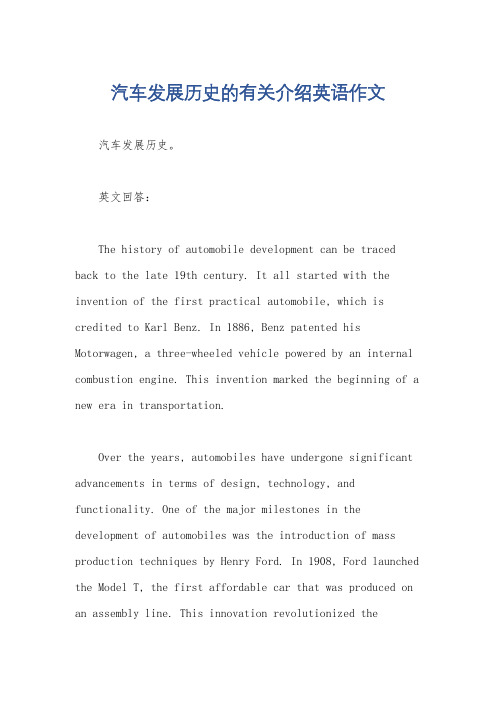
汽车发展历史的有关介绍英语作文汽车发展历史。
英文回答:The history of automobile development can be traced back to the late 19th century. It all started with the invention of the first practical automobile, which is credited to Karl Benz. In 1886, Benz patented his Motorwagen, a three-wheeled vehicle powered by an internal combustion engine. This invention marked the beginning of a new era in transportation.Over the years, automobiles have undergone significant advancements in terms of design, technology, and functionality. One of the major milestones in the development of automobiles was the introduction of mass production techniques by Henry Ford. In 1908, Ford launched the Model T, the first affordable car that was produced on an assembly line. This innovation revolutionized theautomotive industry and made cars accessible to the general public.As time went on, automobile manufacturers continued to innovate and improve their products. The introduction of electric cars in the early 20th century brought about a new wave of environmentally friendly transportation. However, due to limitations in battery technology and infrastructure, electric cars did not gain widespread popularity until recent years.In the 21st century, the automotive industry has witnessed rapid advancements in technology. The development of autonomous vehicles, also known as self-driving cars,has been a major breakthrough. These vehicles have theability to navigate and operate without human intervention, using sensors, cameras, and artificial intelligence. Companies like Tesla, Waymo, and Uber are at the forefrontof this technology.Furthermore, the push for greener and more sustainable transportation has led to the development of hybrid andhydrogen fuel cell vehicles. These vehicles combine traditional internal combustion engines with electric motors, reducing emissions and dependence on fossil fuels. They offer a more environmentally friendly alternative to conventional gasoline-powered cars.In conclusion, the history of automobile development has been marked by continuous innovation and advancementsin technology. From the invention of the first practical automobile by Karl Benz to the introduction of autonomous and electric vehicles, the automotive industry has come a long way. As we move forward, it is likely that we will see even more exciting developments in the field of transportation.中文回答:汽车发展的历史可以追溯到19世纪末。
英语作文汽车发展史180词
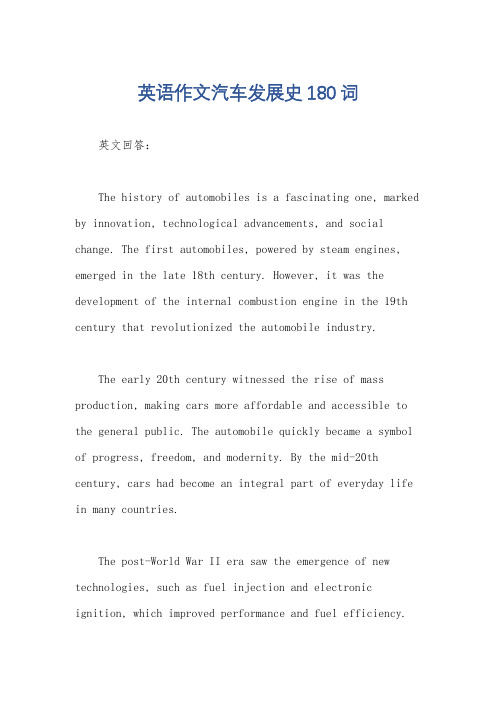
英语作文汽车发展史180词英文回答:The history of automobiles is a fascinating one, marked by innovation, technological advancements, and social change. The first automobiles, powered by steam engines, emerged in the late 18th century. However, it was the development of the internal combustion engine in the 19th century that revolutionized the automobile industry.The early 20th century witnessed the rise of mass production, making cars more affordable and accessible to the general public. The automobile quickly became a symbol of progress, freedom, and modernity. By the mid-20th century, cars had become an integral part of everyday life in many countries.The post-World War II era saw the emergence of new technologies, such as fuel injection and electronic ignition, which improved performance and fuel efficiency.The 1970s energy crisis prompted the development of morefuel-efficient vehicles, such as hybrids and electric cars.In recent decades, the automobile industry has been transformed by advances in electronics, computing, and connectivity. Cars are becoming increasingly autonomous, connected, and environmentally friendly. The future of automobiles holds exciting possibilities, with the adventof self-driving cars, electric vehicles, and sharedmobility services.中文回答:汽车的历史是一段引人入胜的历史,充满了创新、技术进步和社会变革。
汽车发展史的英文作文
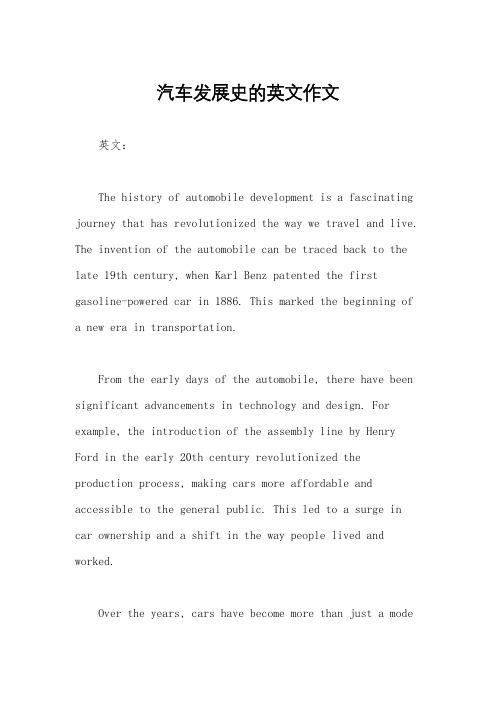
汽车发展史的英文作文英文:The history of automobile development is a fascinating journey that has revolutionized the way we travel and live. The invention of the automobile can be traced back to the late 19th century, when Karl Benz patented the first gasoline-powered car in 1886. This marked the beginning of a new era in transportation.From the early days of the automobile, there have been significant advancements in technology and design. For example, the introduction of the assembly line by Henry Ford in the early 20th century revolutionized the production process, making cars more affordable and accessible to the general public. This led to a surge in car ownership and a shift in the way people lived and worked.Over the years, cars have become more than just a modeof transportation. They have become a symbol of freedom, independence, and status. People often use phrases like "hitting the road" or "going for a drive" to express the joy and excitement of driving. Cars have also become a reflection of personal style and identity, with phrases like "car enthusiast" or "car culture" highlighting the passion and community surrounding automobiles.In recent years, there has been a growing emphasis on sustainability and innovation in the automotive industry. The development of electric and hybrid cars, as well as advancements in autonomous driving technology, are shaping the future of transportation. Phrases like "going green" and "driving into the future" capture the shift towards more environmentally friendly and technologically advanced vehicles.Overall, the history of automobile development is a testament to human ingenuity and progress. From the invention of the first car to the advancements in technology and design, cars have had a profound impact on our lives and society as a whole.中文:汽车发展史是一个迷人的旅程,它彻底改变了我们的出行方式和生活方式。
汽车历史发展的有关介绍英语作文
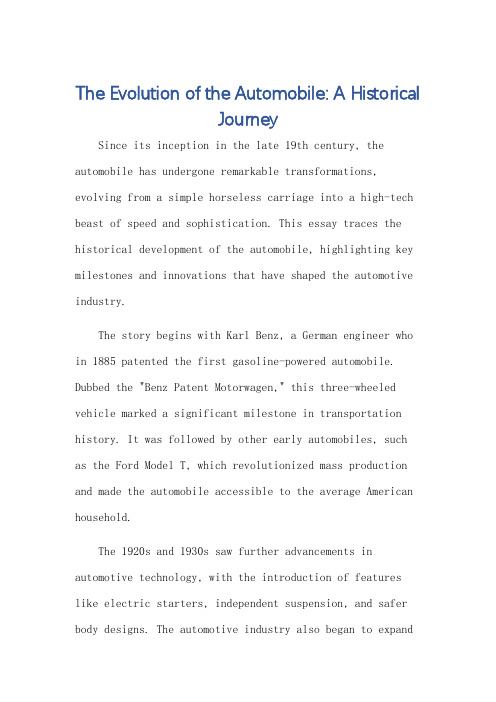
The Evolution of the Automobile: A HistoricalJourneySince its inception in the late 19th century, the automobile has undergone remarkable transformations, evolving from a simple horseless carriage into a high-tech beast of speed and sophistication. This essay traces the historical development of the automobile, highlighting key milestones and innovations that have shaped the automotive industry.The story begins with Karl Benz, a German engineer who in 1885 patented the first gasoline-powered automobile. Dubbed the "Benz Patent Motorwagen," this three-wheeled vehicle marked a significant milestone in transportation history. It was followed by other early automobiles, such as the Ford Model T, which revolutionized mass production and made the automobile accessible to the average American household.The 1920s and 1930s saw further advancements in automotive technology, with the introduction of features like electric starters, independent suspension, and safer body designs. The automotive industry also began to expandglobally, with car manufacturers setting up factories in various countries.The 1950s and 1960s were marked by the "Golden Age" of the automobile, with the emergence of muscle cars, sports cars, and other high-performance vehicles. This era also saw the development of automatic transmissions, air conditioning, and other amenities that made driving more comfortable.The 1970s and 1980s brought about significant changes in automotive design and technology, with the advent of fuel-efficient vehicles, electric cars, and hybrid powertrains. The automotive industry also faced new challenges, such as stricter emission regulations and the rise of environmental concerns.The 21st century has seen the automotive industry continue to evolve, with the development of fully electric vehicles (EVs), autonomous driving technology, and connected car systems. EVs, such as the Tesla Model S and the Nissan Leaf, are gaining popularity due to their zero-emission capabilities and advanced technology features. Autonomous driving technology, which uses sensors andalgorithms to navigate without human intervention, is also being tested and developed by various car manufacturers. Connected car systems, which allow vehicles to communicate with each other and infrastructure, are enhancing road safety and efficiency.In conclusion, the automobile has come a long way since its inception in the late 19th century. From its humble beginnings as a horseless carriage to its current status as a high-tech marvel of engineering, the automobile has constantly evolved and adapted to meet the changing needs of society. As we look ahead to the future, it is exciting to imagine what new innovations and advancements the automotive industry will bring.**汽车历史的演变:一段历史之旅**自19世纪末诞生以来,汽车经历了显著的变化,从简单的无马马车发展成了高速且复杂的高科技产品。
英语作文汽车发展史180词
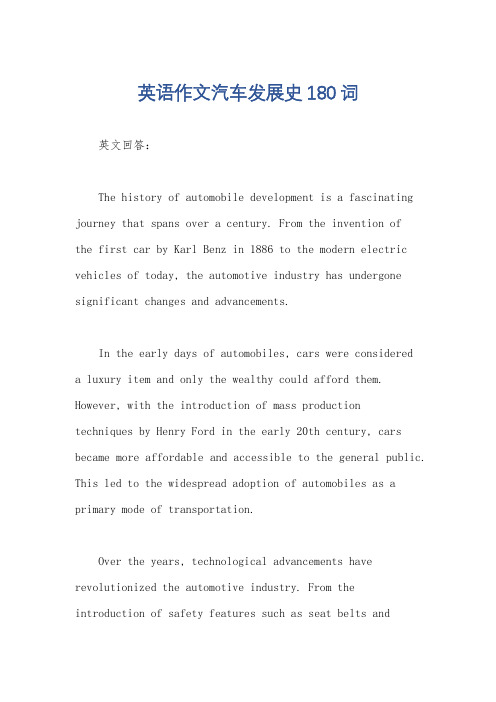
英语作文汽车发展史180词英文回答:The history of automobile development is a fascinating journey that spans over a century. From the invention ofthe first car by Karl Benz in 1886 to the modern electric vehicles of today, the automotive industry has undergone significant changes and advancements.In the early days of automobiles, cars were considereda luxury item and only the wealthy could afford them. However, with the introduction of mass productiontechniques by Henry Ford in the early 20th century, cars became more affordable and accessible to the general public. This led to the widespread adoption of automobiles as a primary mode of transportation.Over the years, technological advancements have revolutionized the automotive industry. From theintroduction of safety features such as seat belts andairbags to the development of self-driving cars, the industry has constantly evolved to meet the changing needs of consumers.One of the most significant developments in recent years is the rise of electric vehicles (EVs). With concerns about climate change and environmental sustainability, many car manufacturers are now focusing on producing electric cars that are more energy-efficient and environmentally friendly.In conclusion, the history of automobile development is a testament to human ingenuity and innovation. As technology continues to advance, we can expect to see even more exciting developments in the automotive industry in the years to come.中文回答:汽车发展史是一个跨越一个世纪的迷人旅程。
汽车发展历史的有关介绍英语作文
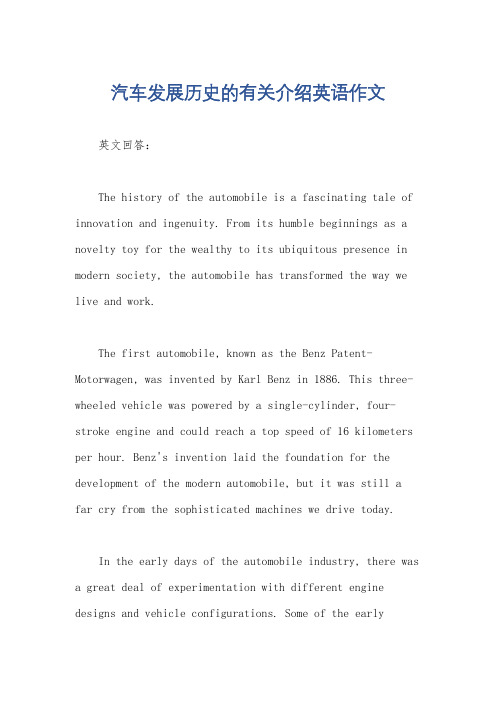
汽车发展历史的有关介绍英语作文英文回答:The history of the automobile is a fascinating tale of innovation and ingenuity. From its humble beginnings as a novelty toy for the wealthy to its ubiquitous presence in modern society, the automobile has transformed the way we live and work.The first automobile, known as the Benz Patent-Motorwagen, was invented by Karl Benz in 1886. This three-wheeled vehicle was powered by a single-cylinder, four-stroke engine and could reach a top speed of 16 kilometers per hour. Benz's invention laid the foundation for the development of the modern automobile, but it was still afar cry from the sophisticated machines we drive today.In the early days of the automobile industry, there was a great deal of experimentation with different engine designs and vehicle configurations. Some of the earlyautomobiles were powered by steam engines or electric motors, while others used gasoline-powered engines. By the turn of the 20th century, the gasoline-powered engine had become the dominant design, and it remains the most common type of engine in use today.The early automobiles were also quite expensive, and they were only affordable for the wealthy. However, as the industry matured and production methods became more efficient, the cost of automobiles began to decline. By the 1920s, automobiles were becoming increasingly affordablefor the average consumer, and car ownership became a symbol of middle-class status.The development of the automobile had a profound impact on society. It made it possible for people to travel greater distances more quickly and easily, and it opened up new possibilities for recreation and leisure. The automobile also played a major role in the development of the suburbs, as people were able to live further away from their workplaces and still commute to work each day.Today, the automobile is an integral part of modern life. It is used for transportation, recreation, and work. The automobile industry is also a major economic force, employing millions of people around the world.中文回答:汽车的发展历史是一部关于创新和创造力的迷人故事。
汽车发展历史的有关介绍英语作文
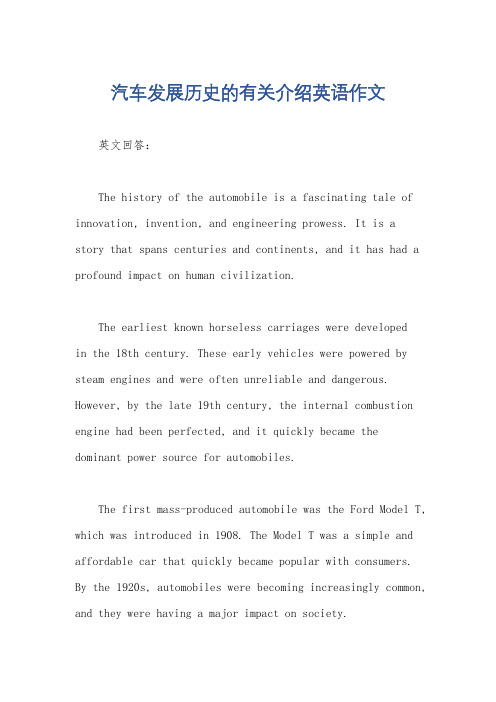
汽车发展历史的有关介绍英语作文英文回答:The history of the automobile is a fascinating tale of innovation, invention, and engineering prowess. It is astory that spans centuries and continents, and it has had a profound impact on human civilization.The earliest known horseless carriages were developedin the 18th century. These early vehicles were powered by steam engines and were often unreliable and dangerous. However, by the late 19th century, the internal combustion engine had been perfected, and it quickly became the dominant power source for automobiles.The first mass-produced automobile was the Ford Model T, which was introduced in 1908. The Model T was a simple and affordable car that quickly became popular with consumers. By the 1920s, automobiles were becoming increasingly common, and they were having a major impact on society.Automobiles allowed people to travel more easily and quickly, and they helped to connect communities. They also played a major role in the development of suburbs and the growth of the automobile industry.The automobile industry continued to grow and innovate throughout the 20th century. New technologies were developed, and cars became more powerful, efficient, and reliable. By the end of the century, automobiles were an essential part of modern life.Today, automobiles continue to play a vital role in society. They are used for transportation, recreation, and work. Automobiles have also had a major impact on the environment, and they are a major source of pollution.The future of the automobile is uncertain. Some experts believe that the internal combustion engine will eventually be replaced by electric motors. Others believe that self-driving cars will become the norm. Whatever the future holds, it is clear that automobiles will continue to play amajor role in human civilization.中文回答:汽车的发展历史是一部关于创新、发明和工程技术的迷人故事。
汽车发展历史的有关介绍英语作文
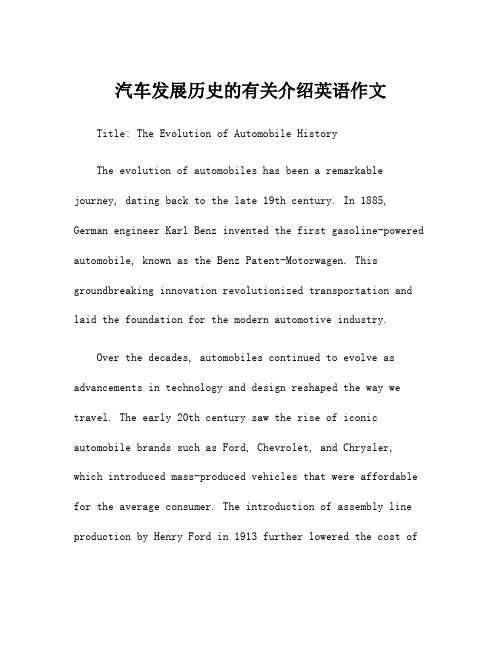
汽车发展历史的有关介绍英语作文Title: The Evolution of Automobile HistoryThe evolution of automobiles has been a remarkable journey, dating back to the late 19th century. In 1885, German engineer Karl Benz invented the first gasoline-powered automobile, known as the Benz Patent-Motorwagen. This groundbreaking innovation revolutionized transportation and laid the foundation for the modern automotive industry.Over the decades, automobiles continued to evolve as advancements in technology and design reshaped the way we travel. The early 20th century saw the rise of iconic automobile brands such as Ford, Chevrolet, and Chrysler, which introduced mass-produced vehicles that were affordable for the average consumer. The introduction of assembly line production by Henry Ford in 1913 further lowered the cost ofautomobiles, making car ownership more accessible to the general public.As the automobile industry grew, so did the range of vehicles available to consumers. From compact sedans to rugged trucks and sleek sports cars, automakers began producing a diverse array of models to cater to different needs and preferences. Innovations such as fuel injection, power steering, and anti-lock brakes enhanced the performance and safety of cars, making them more reliable and efficient.In the mid-20th century, the automotive industry experienced significant advancements with the development of electric cars and hybrid vehicles. Companies like Toyota and Tesla pioneered the use of alternative fuels and sustainable technologies, leading to a more eco-friendly approach to transportation. Electric cars offer zero-emission driving and reduced reliance on fossil fuels, making them a popular choice for environmentally conscious consumers.In recent years, the rise of autonomous vehicles has revolutionized the concept of driving altogether. Companies like Google and Uber have invested heavily in self-driving technology, with the goal of creating safer, more efficient transportation systems. Autonomous vehicles have the potential to drastically reduce accidents and traffic congestion, while also improving accessibility for individuals with disabilities.Looking ahead, the future of automobiles is bright with possibilities. Advancements in artificial intelligence, electric propulsion, and connectivity are paving the way for a new era of smart cars that can communicate with each other and with the surrounding infrastructure. These innovations have the potential to transform the way we travel, making transportation more convenient, sustainable, and efficient.In conclusion, the evolution of automobile history has been a testament to human ingenuity and innovation. From theinvention of the first gasoline-powered car to the development of electric and autonomous vehicles, the automotive industry has continuously pushed the boundaries of what is possible. As we look to the future, it is clear that the automobile will continue to play a vital role in shaping the way we live and move.。
汽车的历史发展英语作文

The Historical Development of AutomobilesThe automobile, a remarkable invention that has profoundly transformed transportation and society, has come a long way since its inception. Tracing the historical development of the automobile reveals a fascinating journey of innovation, technology, and progress.Early BeginningsThe first steam-powered automobile was invented in the late 18th century, but it was not until the mid-19th century that significant progress was made. In 1866, the first practical gasoline-powered internal combustion engine was developed by Nikolaus Otto, marking a significant milestone in automotive history. This engine, known as the Otto cycle, laid the foundation for the modern internal combustion engine.The Horseless CarriageIn 1885, Carl Benz patented the first gasoline-powered automobile, which he named the "Motorwagen." This groundbreaking invention was followed by Gottlieb Daimler's development of the first four-stroke internal combustion engine in 1886. These early automobiles, often referred to as "horseless carriages," were slow and cumbersome compared to today's vehicles but represented a significant leap forward in transportation technology.The Growth of the Automobile IndustryThe early 20th century saw rapid growth in the automobile industry. Henry Ford's introduction of the Model T in 1908 revolutionized mass production, making automobiles more accessible and affordable to the average American. This era also saw the development of key automotive features such as electric starters, headlights, and taillights, which improved safety and convenience.Modern InnovationsIn recent decades, the automobile has continued to evolve with advancements in technology and design. Electric vehicles, self-driving technology, and connected car features such as GPS navigation and infotainment systems are just a few examples of modern innovations that have transformed the automotive landscape.The Future of AutomobilesAs we look ahead, the future of automobiles appears increasingly bright. With advancements in technology, we can expect to see even more innovative features and designs emerge. Autonomous vehicles, electric vehicles with longer ranges, and sustainable transportation solutions are among the exciting possibilities that lie ahead.In conclusion, the historical development of automobiles is a remarkable testament to human ingenuity and progress. From the early steam-powered vehicles to the modern electric and autonomous cars, the automobile has come a long way and continues to evolve, promising an exciting future for transportation and society.汽车是一项深刻改变交通运输和社会的杰出发明,自其诞生以来已经经历了漫长的发展历程。
汽车的历史发展英语作文
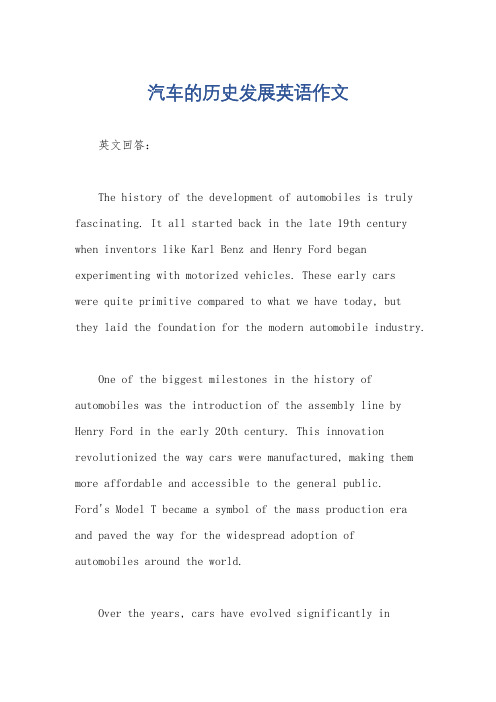
汽车的历史发展英语作文英文回答:The history of the development of automobiles is truly fascinating. It all started back in the late 19th century when inventors like Karl Benz and Henry Ford began experimenting with motorized vehicles. These early carswere quite primitive compared to what we have today, but they laid the foundation for the modern automobile industry.One of the biggest milestones in the history of automobiles was the introduction of the assembly line by Henry Ford in the early 20th century. This innovation revolutionized the way cars were manufactured, making them more affordable and accessible to the general public.Ford's Model T became a symbol of the mass production era and paved the way for the widespread adoption ofautomobiles around the world.Over the years, cars have evolved significantly interms of design, technology, and performance. From the sleek and aerodynamic sports cars of the 1960s to the fuel-efficient hybrids and electric vehicles of today, the automotive industry has come a long way. Innovations like automatic transmission, power steering, and advanced safety features have made driving more convenient and safer than ever before.I remember growing up in the 90s and dreaming about owning a flashy sports car one day. The thrill of driving fast and feeling the wind in my hair was something I always looked forward to. But now, as I've gotten older, I appreciate the comfort and reliability of a luxury sedan or SUV. The advancements in car technology have made long road trips a breeze, with features like adaptive cruise control and lane-keeping assist taking the stress out of driving.Overall, the history of automobiles is a testament to human ingenuity and innovation. From the early pioneers of the industry to the cutting-edge technologies of today, cars have become an essential part of our daily lives. Whether it's commuting to work, running errands, or goingon a road trip, cars have made transportation more convenient and enjoyable for people all over the world.中文回答:汽车的发展历史真是令人着迷。
关于汽车发展史的英语作文

关于汽车发展史的英语作文英文回答:History of Automobiles.The development of automobiles has revolutionized human transportation. In the early 19th century, inventors were experimenting with steam-powered vehicles. In 1885, Karl Benz developed the first internal combustion engine, which used gasoline as fuel. This invention marked the birth of the modern automobile.In the early 20th century, automobiles became more affordable and accessible to the general public. HenryFord's introduction of the Model T in 1908 made cars affordable for the average American family. Over the years, automobiles have undergone significant improvements in performance, safety, and comfort.Today, automobiles are an integral part of our dailylives. They provide convenient and efficient transportation, allowing us to travel far distances quickly and easily. Automobiles have also played a crucial role in economic development, creating jobs and fostering trade.中文回答:汽车发展史。
英语作文汽车发展史英语作文
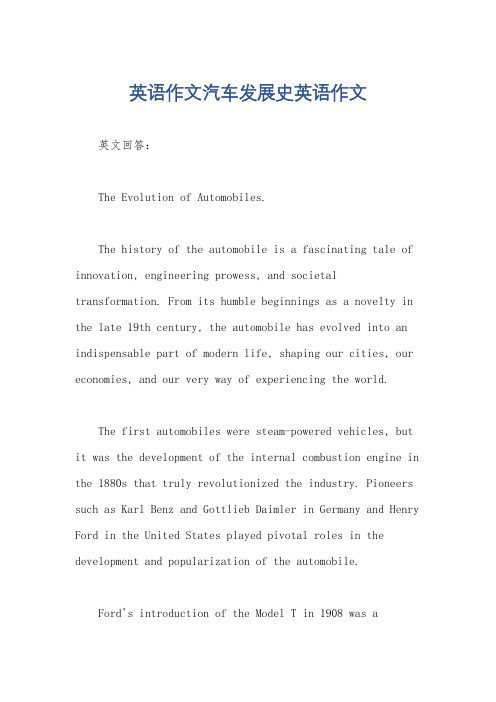
英语作文汽车发展史英语作文英文回答:The Evolution of Automobiles.The history of the automobile is a fascinating tale of innovation, engineering prowess, and societal transformation. From its humble beginnings as a novelty in the late 19th century, the automobile has evolved into an indispensable part of modern life, shaping our cities, our economies, and our very way of experiencing the world.The first automobiles were steam-powered vehicles, but it was the development of the internal combustion engine in the 1880s that truly revolutionized the industry. Pioneers such as Karl Benz and Gottlieb Daimler in Germany and Henry Ford in the United States played pivotal roles in the development and popularization of the automobile.Ford's introduction of the Model T in 1908 was awatershed moment. Its affordability and practicality madeit possible for the average person to own a car, transforming transportation and creating new possibilities for travel and commerce.In the first half of the 20th century, the automobile industry underwent rapid technological advancements. Electric starters, hydraulic brakes, and automatic transmissions made cars safer and easier to operate. The invention of the assembly line allowed for mass production, further driving down costs and making cars more accessible.Post-World War II, the automobile industry flourished. The rise of suburbs and the growth of the middle class created a huge demand for cars. Manufacturers responded with a wide range of models, from compact and economical to luxurious and powerful.In recent decades, environmental concerns have become increasingly important. The development of hybrid and electric vehicles, as well as advancements in fuel efficiency, have made cars more environmentally friendly.Self-driving cars and other autonomous vehicle technologies are also on the horizon, promising to transform the way we interact with our vehicles.中文回答:汽车的发展史。
英语作文汽车发展史英语作文
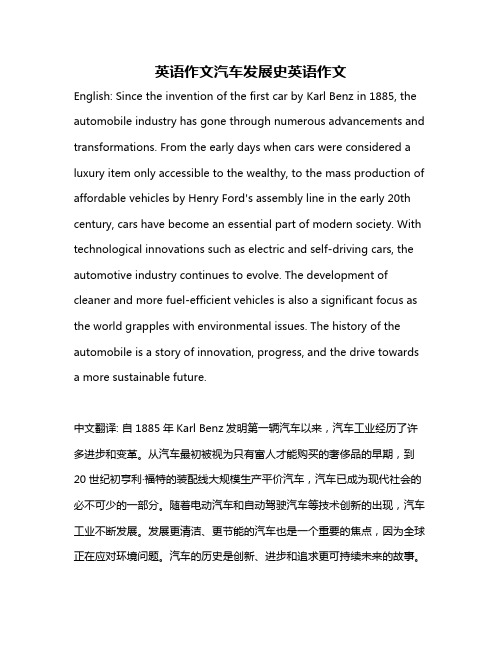
英语作文汽车发展史英语作文English: Since the invention of the first car by Karl Benz in 1885, the automobile industry has gone through numerous advancements and transformations. From the early days when cars were considered a luxury item only accessible to the wealthy, to the mass production of affordable vehicles by Henry Ford's assembly line in the early 20th century, cars have become an essential part of modern society. With technological innovations such as electric and self-driving cars, the automotive industry continues to evolve. The development of cleaner and more fuel-efficient vehicles is also a significant focus as the world grapples with environmental issues. The history of the automobile is a story of innovation, progress, and the drive towards a more sustainable future.中文翻译: 自1885年Karl Benz发明第一辆汽车以来,汽车工业经历了许多进步和变革。
介绍一下关于汽车的发展史英语作文200字
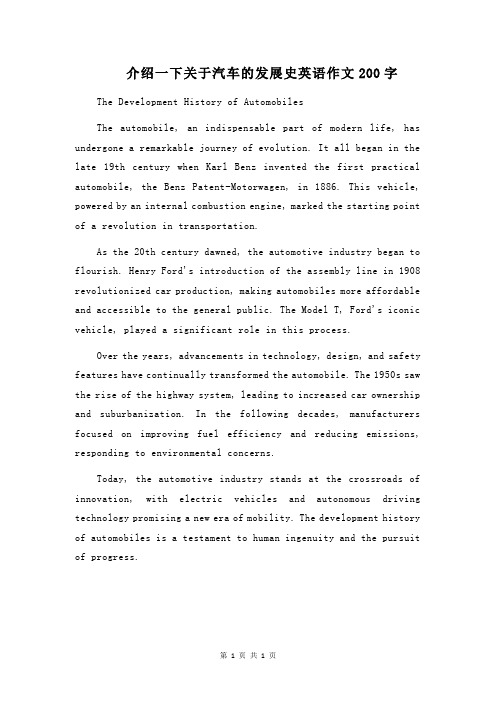
介绍一下关于汽车的发展史英语作文200字The Development History of AutomobilesThe automobile, an indispensable part of modern life, has undergone a remarkable journey of evolution. It all began in the late 19th century when Karl Benz invented the first practical automobile, the Benz Patent-Motorwagen, in 1886. This vehicle, powered by an internal combustion engine, marked the starting point of a revolution in transportation.As the 20th century dawned, the automotive industry began to flourish. Henry Ford's introduction of the assembly line in 1908 revolutionized car production, making automobiles more affordable and accessible to the general public. The Model T, Ford's iconic vehicle, played a significant role in this process.Over the years, advancements in technology, design, and safety features have continually transformed the automobile. The 1950s saw the rise of the highway system, leading to increased car ownership and suburbanization. In the following decades, manufacturers focused on improving fuel efficiency and reducing emissions, responding to environmental concerns.Today, the automotive industry stands at the crossroads of innovation, with electric vehicles and autonomous driving technology promising a new era of mobility. The development history of automobiles is a testament to human ingenuity and the pursuit of progress.第1页共1页。
- 1、下载文档前请自行甄别文档内容的完整性,平台不提供额外的编辑、内容补充、找答案等附加服务。
- 2、"仅部分预览"的文档,不可在线预览部分如存在完整性等问题,可反馈申请退款(可完整预览的文档不适用该条件!)。
- 3、如文档侵犯您的权益,请联系客服反馈,我们会尽快为您处理(人工客服工作时间:9:00-18:30)。
After Watt improved the steam engine (蒸汽 机),French Army Engineer Cugnot produced the first steam engine driving a car.
Carl. Mercedes-Benz(奔驰 汽车),now Germany's famous car company that is the first generation of fathers. October 1885, Mercedes-Benz design and manufacture of a gasoline (汽油)loading three cars. January 29, 1886, Mercedes-Benz was patented this day is recognized as the birthday of the car.
The most expensive automobile
Silver ghost which was made by Rolls-Royce(劳斯莱斯) was the most expensive and famous automobile in the world. Silver ghost’s price is over 20 million pounds。It was the vehicle of the britain's queen Elizabeth. And it stopped producing at 1925.
Top of automobile
Future automobile
Characters of future cars
Diesel engine was absorbed by more cars; Electric automobile will move into the practical stage; Automobile safety standards will be more strict; New materials which may replace steel car bodies to lower the weight; Various electronic device will be applied on the automobile;
LOGO
Development in china
1901, Cars first appeared in Shanghai ,imported from Hong Kong by Leinz, a Hungarian businessman. 1902, The first car owner was Empress Dowager Cixi of the Qing Dynasty
Development in china
Rapid and comprehensive development stage
Domestic(家庭的) passenger car production could not meet demand.
China’s answer to the import binge was to sign a series of joint-venture(合资企业) passenger car production agreements.
The first quadricycle(四轮车)
In 1896, the Germany’s engineer Daimler fixed his 1.1hp gasoline-powered engine on a quadricycle with the help of his friend Wilhelm Maybach ,and this is the famous “Daimler 1”.
Several enterprises entered the automobile industry since 1994. China zoomed past Japan to become the world's No. 2 vehicle (车辆)market in 2006 and passed the United States to be the biggest in 2009.
Development in china
1928,Zhang Xueliang is the first men who organized to make automobile
Development in china
Start-up stage
1953,The first modern automobile factory First Automobile Works began production. 1956,the CA-10 4-ton Jiefang commercial truck was produced by the First Automobile Works
The first motor bike
In 1885, the Germany’s engineer Daimler install the 1.1hp engine made by himself on a wood bicycle,then the first motor bike appeared.
Development in china
explore and Growth stage
1958: The first 2½ ton light duty truck 1958: Nanjing Automobile Works, previously a vehicle servicing unit of the Army, was established
The develope about car
Technical Background---the carriage(四轮马车)
Before the aotomobile come out, the carriage is the best land-based huground----industrial revolution
